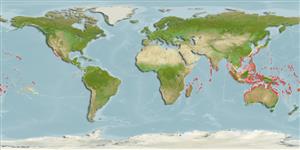Common names from other countries
Environment: milieu / climate zone / depth range / distribution range
Écologie
marin récifal; profondeur 1 - 15 m (Ref. 27020). Tropical
Indo-Pacific and Western Central Pacific.
Taille / Poids / Âge
Maturity: Lm ? range ? - ? cm
Max length : 9.9 cm SL mâle / non sexé; (Ref. 27020)
Épines dorsales (Total) : 7; Rayons mous dorsaux (Total) : 23 - 25; Épines anales: 3; Rayons mous anaux: 19 - 21; Vertèbres: 10 - 18. Adults' body light brown with scattered vertically elongate dark brown spots. Large pores in interorbital space absent (except in small juveniles). Preopercular spine projecting upward. Caudal vertebrae rarely up to 19. Lateral line scales: anterior 32-38; posterior 14-28 (usually 19-21) when fully developed. Longitudinal line series 53-59.
A shallow-water species (Ref. 27020). Found among corals of wave-washed seaward reefs (Ref. 1602). Benthic species (Ref. 7300, 58302). Solitary and cryptic (Ref 90102).
Life cycle and mating behavior
Maturities | Reproduction | Spawnings | Egg(s) | Fecundities | Larves
Randall, J.E. and C.C. Baldwin, 1997. Revision of the serranid fishes of the subtribe Pseudogrammina, with descriptions of five new species. Indo-Pac. Fish. (26):56 p. (Ref. 27020)
Statut dans la liste rouge de l'IUCN (Ref. 130435)
CITES (Ref. 128078)
Not Evaluated
Menace pour l'homme
Harmless
Utilisations par l'homme
Pêcheries: sans intérêt
Outils
Articles particuliers
Télécharger en XML
Sources Internet
Estimates based on models
Preferred temperature (Ref.
115969): 24.5 - 29.3, mean 28.1 (based on 2338 cells).
Phylogenetic diversity index (Ref.
82804): PD
50 = 1.0000 [Uniqueness, from 0.5 = low to 2.0 = high].
Bayesian length-weight: a=0.01148 (0.00451 - 0.02922), b=3.06 (2.84 - 3.28), in cm Total Length, based on LWR estimates for this (Sub)family-body shape (Ref.
93245).
Niveau trophique (Ref.
69278): 3.7 ±0.6 se; based on size and trophs of closest relatives
Fishing Vulnerability (Ref.
59153): Low vulnerability (10 of 100).
